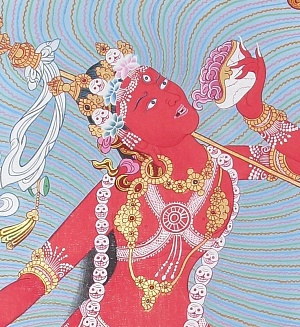News
-
 Pranayama workshop, Mar 1-7
Pranayama workshop, Mar 1-7
-
 21-day Pranayama challenge
21-day Pranayama challenge
-
 Nāda meditation workshop, January 8-12
Nāda meditation workshop, January 8-12
-
 April 3, Navaratri with Yogi Matsyendranath Maharaj, Australia, Queensland
April 3, Navaratri with Yogi Matsyendranath Maharaj, Australia, Queensland
-
 March 17, 2020. Purifiying Pranayama With Yogi Matsyendra Nath
March 17, 2020. Purifiying Pranayama With Yogi Matsyendra Nath
-
 November 2019, Tantra Workshop Series in Argentina
November 2019, Tantra Workshop Series in Argentina
-
 Workshop in Gualeguaychu
Workshop in Gualeguaychu
-
 17-18 November 2018, Yogi Matsyendranath in Źarate (Argentina)
17-18 November 2018, Yogi Matsyendranath in Źarate (Argentina)
-
 15-16 November 2018, Yogi Matsyendranath visit to Uruguay
15-16 November 2018, Yogi Matsyendranath visit to Uruguay
-
 12 Nov 2018, Lecture at USAL (Salvador University)
12 Nov 2018, Lecture at USAL (Salvador University)
-
 10-11 November 2018, Workshops in Quilmes and La Plata (Argentina)
10-11 November 2018, Workshops in Quilmes and La Plata (Argentina)
-
 8 November 2018, Open conference in Necochea (Argentina)
8 November 2018, Open conference in Necochea (Argentina)
-
 2,3,4 November 2018 - Participating in XVI Retreat International of Yoga and Meditation
2,3,4 November 2018 - Participating in XVI Retreat International of Yoga and Meditation
-
 Programme in Québec (Canada) 13-16 June
Programme in Québec (Canada) 13-16 June
-
 Melbourne Book Launch
Melbourne Book Launch
-
 4-years Summer Program
4-years Summer Program
-
 Biography of a Russian Yogi
Biography of a Russian Yogi
-
 November 2017, Visit of Yogi Matsyendranath to Argentina
November 2017, Visit of Yogi Matsyendranath to Argentina
-
 Satsangs of Yogi Matsyendranatha Maharaj in Berlin
Satsangs of Yogi Matsyendranatha Maharaj in Berlin
-
 Seminars and trainings in June-July 2015 (France)
Seminars and trainings in June-July 2015 (France)
Dakini
Dakini

डाकिनी, ḍākinī, also दाकिनी, dākinī
Presumably the word comes from the Sanskrit root दी, dī — "flying, hovering".
-
In Hinduism, a class of demonic or semi-divine female beings constituting the entourage of the goddess Kali, and sometimes other goddesses of the Tantric pantheon (Dasha-Mahavidya), taking different forms and giving secret teachings in a symbolic language. It is believed that dakinis can give practitioners magical abilities, often secular. They are usually portrayed as particularly horrifying and aggressive creatures of an anthropomorphic appearance. In folklore, dakinis are correlated with harmful spirits, drinking blood of babies, sending spoilage and disease to humans and animals.
-
In the sacral anatomy of Indian tantrism, Ḍākinī, Rākiṇī, Lākiṇī, Kākiṇī, Śākiṇī, Hākiṇī, and Yākiṇī — Yoginīs symbolically designate different types of Shakti or forces controlling certain chakras. They are also named door guardians, they protect knowledge and powers, which are included in chakras, from unworthy, weak practitioners. These goddesses are also related with physical substances of the body (dhatu).

The Dakini energy resides in muladhara. Her ferocious appearance and weapons cause fear among those who are not spiritually ready. She holds in her four hands: a staff with a skull (khatvanga), a bowl, a trident and a sickle-shaped weapon (kartika). A spiritually developed practitioner sees in the vessel the nectar of immortality (amrita), which can flow inside him through deep meditation, and he continues to go to immortality despite death of the body, which is symbolized by the skull. Kartika is the spiritual knowledge that destroys everything mundane. Trident eliminates three forms of pain arising inside the body, caused by external influences and pain from an invisible source. Veneration and meditation on Dakini cultivate spiritual qualities.
“The Goddess Dakini resides in muladhara; She has four beautiful hands and shiny red eyes; She glows like a lot of suns ascending at the same time; she always carries divine light of knowledge (for bestowing to yogins)”
Ṣaṭcakranirūpaṇa (7)The texts of Shrividya Tradition ("Varivasyā-rahasya", "Yoginī-hridaya", "Tantrarāja tantra" and others) place Dakini in vishuddha-chakra. Together with other chakra goddesses, she constitutes the subtle body of Kundalini-shakti (Lalita Goddess) and is worshiped in shodha-nyasa. In “Lalitā Sahasranāma” several names of the Goddess Lalita Tripurasundari refer to Dakini:
Kundalini residing in the vishuddha-chakra (viśuddhicakranilayā-475) takes form of the yogini Dakini (ḍākinīśvarī-484). She has one face (vadanaikasamanvitā-479) of pink colour (āraktavarṇā-476) and 3 eyes (trilocanā-477). She governs the skin (tvaksthā-481) and prefers food cooked in milk (pāyasānnapriyā-480). She is endowed with weapons: khatvanga, khanga, trishikha and mahacharma (khaṭvāṅgādipraharaṇā-478). In this form, she confuses the ignorant. She is surrounded by great shaktis named Amrita, etc. (amṛtādimahāśaktisaṃvṛtā-483).
Finally, according to "Shrīmattotara Tantra", the text of Kubjika tradition, Dakini has the head of a cat and eight arms. Together with other Yoginis, she is located in the Yogini-chakra (in the throat area). The consort of Dakini is one of Ashtabhairavas – Asitanga.
-
In Buddhism Vajrayana, companions of the Yidam Deities, such as Nairatmya, Kurukulla, Vajrayogini, Vajravarahi, Simhamukha, symbolically express the principle of the femininity – prajna. They are also honored as defenders of Buddha's teachings, awakening the original state of consciousness and granting sacral knowledge. In tantric Buddhism, they act as one of the objects of refuge. In the popular cult, they are identified with the numerous local goddesses of the pre-Buddhist pantheon. Usually depicted as seductive young girls or vice versa, old and decrepit old women, and also with characteristic zoomorphic totem signs — the heads of various animals. In Tibet and Mongolia, a dakini can be called a female practitioner in the status of a lama, who has special attributes and abilities.

